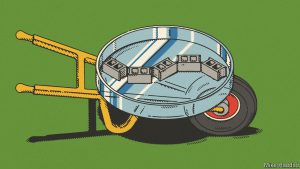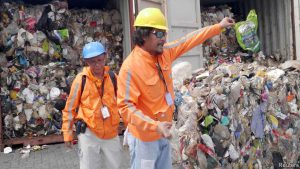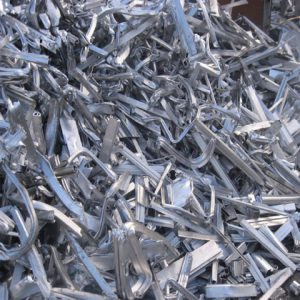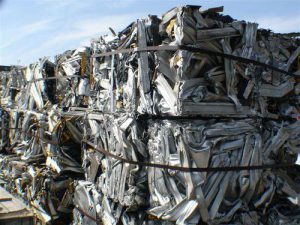
Budget Review 2020–21 Index
Juli Tomaras
It is generally recognised that Australia has a recycling and waste management problem. A 2018 National Waste Report prepared for the Commonwealth Department of the Environment and Energy revealed that ‘Australia generates more waste than the average Western economy’—an estimated 67 million tonnes (Mt) of waste in 2016–17, equivalent to 2.7 tonnes per capita—and is also recycling less than average. In 2016–17 about 6.7 Mt of organic waste (food, garden and other organic waste, which creates methane-rich greenhouse gases as it decomposes) was deposited in landfill. Collection of methane generated from the anaerobic decay of organic waste in large landfills can be used to generate electricity for sale into the grid. Only a small percentage of our waste is converted to energy. Australia also lags behind the rest of the developed world in the uptake of (solid) waste-to-energy technology.
Up until recently, Australia sent much of its waste overseas as a cheaper alternative to local recycling, with China a major destination for this waste. China’s ban from January 2018 on the import of ‘24 types of solid waste, including various plastics and unsorted mixed papers, and the setting of more stringent standards for contamination levels’ was followed by other countries restricting or re-thinking the importation of solid waste. Suddenly, thousands of tonnes of recyclables had nowhere to go and the relatively higher cost of domestic recycling, coupled with a lack of scaled infrastructure to sort and recycle, led to more waste going to landfill.
Responding to the challenges—‘our waste, our responsibility’
In 2018 the federal, state and territory governments worked together to update the National Waste Policy, which explicitly endorses the shift to a circular economy (see discussion below) and ‘provides a national framework for waste and resource recovery in Australia’. The Policy ‘outlines roles and responsibilities for collective action by businesses, governments, communities and individuals’, though ‘it does not remove the need for governments, businesses and industries to implement tailored solutions in response to local and regional circumstances’. In 2019 an attendant National Waste Policy Action Plan was created, ensuring there are targets, actions, appropriate funding and clearer allocations of responsibility, so as to give effect to the National Waste Policy. The targets set out in the Action Plan include:
- a ban on the export of waste plastic, paper, glass and tyres, commencing in the second half of 2020
- an 80 per cent average recovery rate from all waste streams by 2030
- significantly increasing the use of recycled content by governments and industry
- making comprehensive, economy-wide and timely data publicly available to support better consumer, investment and policy decisions
- halving the amount of organic waste sent to landfill by 2030 and
- phasing out problematic and unnecessary plastics by 2025.
In August 2019 the Council of Australian Governments (COAG) agreed to establish a timetable to progressively ban the export of plastic, paper, tyres and glass waste. In March 2020 COAG released a Response Strategy to Implement the August 2019 Agreement of the Council of Australian Governments to implement its export ban decision, and build the necessary infrastructure, create the settings and develop the capacity for Australia to manufacture and re-manufacture high-value commodities. This strategy is one necessary step in the transition to a circular economy and was the product of a COAG waste export ban consultation with industry peak bodies and a COAG Decision Regulatory Impact Statement, followed by a parliamentary Inquiry into Australia’s Waste Management and Recycling Industries.
In 2019, as part of their election platforms, both the ALP and the Liberal Party pledged to tackle the waste management and recycling crisis. Among other things, the Liberal Party stated that it would commit:
$100 million [to the] Australian Recycling Investment Fund through the Clean Energy Finance Corporation to support manufacturing of lower emissions and energy-efficient recycled content products, such as recycled content plastics and paper/pulp.
$20 million for a new Product Stewardship Investment Fund to accelerate work on new industry-led recycling schemes, including for batteries, electrical and electronic products, photovoltaic systems and plastic oil containers.
$20 million to find new and innovative solutions to plastic recycling and waste through the Cooperative Research Centres Projects grants program.
Commitment to a circular economy—a paradigmatic shift?
A circular economy is about changing the way we design, produce, make, sell and use products to minimise waste, the use of energy in their production, demand for virgin materials, landfill, and our impact on the environment. Thus, it aims to keep materials and resources in use for as long as possible by making products with recyclable and reusable materials that last longer and, for a variety of goods, is generally supported by a mandated ‘right to repair’ or product standard that enables the goods to be easily refurbished. Material product inputs are recovered, recycled and re-manufactured, rather than disposed of in landfill.
Key spending measures in support of a circular economy
Growing Australia’s manufacturing and re-manufacturing sector is a key budget theme. Recycling and clean energy manufacturing is recognised as a National Manufacturing Priority in the Government’s Modern Manufacturing Strategy. The priorities, which reflect Australia’s identified ‘areas of competitive advantage’ and emerging areas of priority, are the focus of federal government budget funding, reforms and policies in the years ahead. The funding is aimed at stopping ‘more than 600,000 tonnes of waste ending up in landfill’ and by doing so, is estimated to assist in ‘creat[ing] a further 10,000 jobs’.
In Budget Measures: Budget Paper No. 2: 2020–21 the Government announced expenditure of $249.6 million over four years from 2020–21 ‘to support domestic waste management, reduce pressure on our environment and create economic opportunities for Australians’ (p. 209). This expenditure had already been committed in a series of announcements in the past months preceding the Budget, and is part of a national strategy on recycling infrastructure to drive a transformation of Australia’s waste management and recycling capacity. It includes:
- $190.0 million to establish a Recycling Modernisation Fund (RMF) that, along with co-funding from the states, territories and industry, is ‘expected to generate $600 million of recycling investment to drive transformation of Australia’s waste and recycling capacity’ (p. 209). The funding is being delivered through the states and territories, with their contributions matched dollar for dollar by the federal government. There is an expectation that industry will also provide matching funding. The RMF will support innovative investment in new infrastructure to sort, process and re-manufacture materials such as mixed plastic, paper, tyres and glass. This initiative follows as a direct consequence of the Recycling and Waste Reduction Bills before the Parliament, which aim to ban the export of unprocessed waste plastic, paper, glass and tyres with a view to transforming domestic waste management and encouraging the recycling sector to collect, recycle, reuse and convert waste into a resource. As Australia stops these exports, the Government has indicated it is keen to ensure that the potential value in recyclables is not lost through landfilling; rather, the value inherent in those waste streams should be captured and put back into manufacturing supply chains.
- $35.0 million to ‘implement the Commonwealth’s commitments under the National Waste Policy Action Plan, which sets the direction for waste management and recycling in Australia until 2030’ (Ibid). These funds will go toward supporting targets, such as reducing food waste and organic waste over the next ten years, through for example, the Voluntary Commitment Program for industry to start reducing food waste.
- $24.6 million to ‘improve Australian national waste data to measure recycling outcomes and track progress against national waste targets’ (Ibid). A 2018 Senate Environment Committee inquiry received evidence that ‘data around waste generation and diversion remains notoriously poor’ (p. 17). The states and territories do not have consistent data definitions, or readily available real time data necessary to plan investments, and monitor and measure activity, performance and outcomes (Ibid., paras 2.36 to 2.61). The Committee found that there was ‘a lack of national data on many waste issues that would otherwise underpin the sustainable management of Australia’s waste streams’ (Ibid., p. 14).
Budget Paper No. 2 also includes the following measures:
- $10.0 million over four years from 2020–21 to support industry-led collaborative research projects, through the Cooperative Research Centres Projects program, to develop innovative solutions for recycling. The cost of this measure will be met from the existing resources of the Department of Industry, Science, Energy and Resources (p. 115) and
- as part of funding for infrastructure investments ($184.7 million over ten years from 2020–21), an amount will be used to develop ‘national guidelines and model specifications for the use of recycled materials in road construction’ (p. 144).
In Budget Measures: Budget Paper No. 3: 2020–21 the Government has provided $188.9 million over the forward estimates for improved recycling outcomes by addressing critical infrastructure gaps in Australia’s waste management and resource recovery system. The precise allocation of this funding has not yet been determined for every state and territory (p. 64).
Stakeholder comments
The announcements on funding for waste management and recycling have been generally welcomed by industry stakeholders. This follows concern expressed in 2019 by the Australian Council of Recycling (ACR) that ‘4.5m tonnes of waste could end up in domestic landfill without major public investment’. ACR stated the COAG agreement on waste and recycling needed to be backed up with funding and action to be ‘transformative’ to the sector. The CEO of the Waste Management and Resource Recovery Association of Australia has stated that there are ‘still many opportunities around procurement of recycled materials that should be tapped into’ by the federal government, as the largest procurer of goods and materials in Australia.





